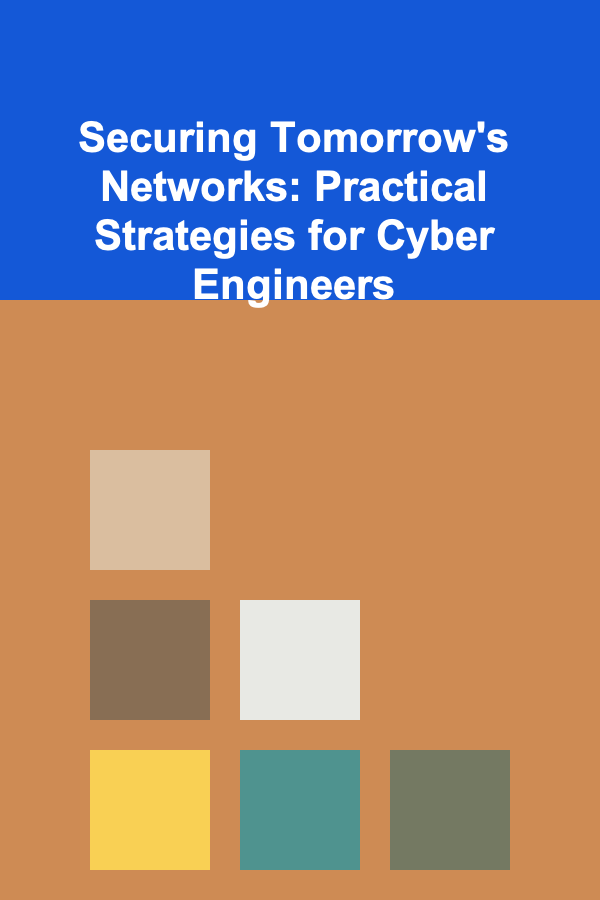
Securing Tomorrow's Networks: Practical Strategies for Cyber Engineers
ebook include PDF & Audio bundle (Micro Guide)
$12.99$5.99
Limited Time Offer! Order within the next:

In an increasingly digital world, securing networks has become more critical than ever. With cyber threats evolving at an alarming rate, it's essential for cyber engineers to stay ahead of the curve. Ensuring the security of networks isn't just about building firewalls or applying patches---it's a holistic approach that requires a deep understanding of modern technologies, threat landscapes, and proactive measures. This guide will explore actionable strategies for cyber engineers to secure tomorrow's networks and build resilient infrastructures.
Understand the Threat Landscape
The first step in securing a network is understanding the ever-evolving cyber threat landscape. Cyber threats come in many forms, from simple phishing attacks to sophisticated ransomware campaigns. The threat landscape is dynamic, with new vulnerabilities, attack vectors, and techniques emerging regularly.
Key Actions:
- Track Emerging Threats: Stay updated with the latest threat intelligence. Subscribe to threat feeds, participate in security forums, and follow cybersecurity blogs. Engage with threat intelligence platforms like MISP (Malware Information Sharing Platform) or threat databases such as MITRE ATT&CK to gain insights into common attack techniques.
- Leverage Automated Threat Detection: Use machine learning-driven systems to detect emerging threats. These systems can analyze large amounts of data for anomalies that might indicate new attack vectors.
- Engage in Red Teaming: Regularly test your network's security by simulating advanced persistent threats (APTs) using red teaming exercises. This helps identify weaknesses before real attackers can exploit them.
Zero Trust Architecture: The New Standard
Zero Trust (ZT) is a security model that assumes no entity, whether inside or outside the organization, is inherently trustworthy. It advocates for verifying every request to access resources, regardless of whether the request comes from inside or outside the network.
Key Actions:
- Enforce Identity and Access Management (IAM): Implement strict IAM policies. Use multi-factor authentication (MFA) and role-based access control (RBAC) to ensure that only authenticated users can access sensitive resources.
- Segment the Network: Divide your network into microsegments. This limits the lateral movement of attackers within the network. By isolating critical assets, even if one segment is breached, the attacker cannot easily spread across the entire network.
- Continuous Monitoring: Implement real-time monitoring and logging of every user and device activity. Use tools like Security Information and Event Management (SIEM) systems to analyze access patterns and detect suspicious behavior.
Secure the Cloud Infrastructure
As more businesses transition to the cloud, securing cloud-based infrastructures is no longer optional. Cloud environments are unique because of their scalability, flexibility, and shared responsibility model between the service provider and the client. Cyber engineers need to ensure that both public and private clouds are securely configured and continuously monitored.
Key Actions:
- Implement Strong Cloud Security Controls: Utilize security controls such as encryption at rest and in transit, identity federation, and multi-factor authentication for cloud services. Leverage cloud-native security tools provided by platforms like AWS, Azure, and Google Cloud.
- Know the Shared Responsibility Model: Understand the division of security responsibilities between the cloud provider and your organization. Cloud providers typically secure the physical infrastructure, while the organization is responsible for securing the data, applications, and access.
- Secure APIs: APIs are a critical part of modern cloud-based systems. Ensure they are properly secured using standards like OAuth 2.0 and OpenID Connect for authentication and authorization.
Employ Strong Network Segmentation and Isolation
Network segmentation is a critical defense mechanism that limits the impact of a potential breach. Proper segmentation can prevent attackers from moving laterally through the network and accessing sensitive resources.
Key Actions:
- Design Segmented Network Zones: Create multiple layers of security by dividing your network into different zones based on sensitivity. For example, isolate operational systems from corporate data, and separate public-facing servers from internal networks.
- Implement Firewalls and Access Control Lists (ACLs): Firewalls and ACLs act as barriers between network segments, allowing only authorized traffic to pass through. Use micro-segmentation where each individual device or user is isolated, further limiting the impact of a breach.
- Use Virtual Local Area Networks (VLANs): VLANs allow you to logically separate traffic even within the same physical infrastructure. They can segment different departments, services, or data types to add an additional layer of control over network access.
Adopt Automated Threat Mitigation Tools
Manual network security operations can be slow and error-prone, making it crucial to adopt automated solutions for threat detection, response, and mitigation. Automation helps cyber engineers respond quickly to incidents and reduces human error, increasing the efficiency of security operations.
Key Actions:
- Deploy Intrusion Detection and Prevention Systems (IDPS): IDPS tools can automatically detect and prevent malicious activity. By integrating these tools with machine learning and threat intelligence, they can adapt to new attack methods in real-time.
- Automate Patch Management: Vulnerability management is an ongoing process. Automate patching and vulnerability scanning to ensure that no security gaps are left unaddressed. Tools like Qualys or Tenable can scan your network and automatically deploy patches where necessary.
- Leverage Security Automation and Orchestration: Use Security Orchestration, Automation, and Response (SOAR) platforms to automate repetitive security tasks, streamline incident response workflows, and reduce response times.
Secure Endpoints: The First Line of Defense
With the increasing number of remote workers and connected devices, endpoint security is a critical aspect of securing tomorrow's networks. Devices such as laptops, smartphones, and IoT devices can serve as entry points for attackers if not properly secured.
Key Actions:
- Use Endpoint Detection and Response (EDR) Tools: EDR tools continuously monitor and respond to security threats on endpoint devices. They provide advanced threat detection capabilities, such as identifying unusual processes, file modifications, or network activity.
- Encrypt Devices and Data: Use encryption to protect sensitive data on endpoints. Even if an attacker gains access to a device, encryption ensures the data remains unreadable without the correct decryption key.
- Implement Mobile Device Management (MDM): For organizations with a mobile workforce, implement MDM solutions to enforce security policies, such as remote wipe, strong encryption, and app whitelisting.
Patch Management and Vulnerability Remediation
Network security is only as strong as the weakest link. One of the easiest ways for attackers to gain access to a network is by exploiting known vulnerabilities. Regular patching is essential to close these vulnerabilities before attackers can exploit them.
Key Actions:
- Create a Comprehensive Patch Management Strategy: Establish a policy for patching and update all systems, software, and hardware regularly. Prioritize patching based on the criticality of vulnerabilities, with a particular focus on high-risk CVEs (Common Vulnerabilities and Exposures).
- Conduct Regular Vulnerability Scanning: Implement tools to scan your network regularly for vulnerabilities. Tools like Nessus, OpenVAS, or Qualys can identify potential security weaknesses and help you remediate them.
- Implement a Zero-Day Response Plan: Zero-day vulnerabilities are exploited before a patch is available. Establish a plan for handling zero-day threats, including mitigating the vulnerability temporarily while awaiting an official fix.
Ensure Data Privacy and Compliance
With global regulations like the General Data Protection Regulation (GDPR) and the California Consumer Privacy Act (CCPA), protecting user data has become a legal requirement. Cyber engineers must ensure that sensitive data is secure and that the organization complies with relevant regulations.
Key Actions:
- Encrypt Sensitive Data: Use end-to-end encryption to protect sensitive data in transit and at rest. Encryption ensures that even if attackers intercept data, they cannot read or misuse it.
- Implement Data Loss Prevention (DLP): DLP systems help monitor and protect against unauthorized data transfers. They can prevent data leaks by detecting attempts to send sensitive information outside the organization.
- Regularly Audit and Review Access: Conduct regular audits of user and system access to sensitive data. Ensure that only authorized personnel have access, and implement principles of least privilege.
Conclusion
Securing tomorrow's networks requires a comprehensive approach that involves proactive defense, continuous monitoring, and a deep understanding of emerging threats. Cyber engineers must stay ahead of the curve by adopting new technologies, implementing robust security frameworks like Zero Trust, and ensuring that all aspects of the network, from cloud services to endpoints, are securely configured. By using automation, segmentation, and proper patch management, engineers can create resilient, adaptive systems that are capable of defending against the ever-evolving threat landscape.
Ultimately, network security is not a one-time task but an ongoing journey. As technology continues to evolve, so too must our strategies for defending networks. By implementing these practical strategies, cyber engineers can help ensure the security and integrity of networks in the years to come.
Reading More From Our Other Websites
- [Tie-Dyeing Tip 101] From Ordinary to Extraordinary: Transform Your Fabrics with Clothespin Tie-Dye Techniques
- [Personal Care Tips 101] How to Apply Blush for a Flattering, Sculpted Appearance
- [Organization Tip 101] How to Organize Pet Photography Essentials for Memorable Moments
- [Home Budget Decorating 101] How to Transform Upcycled Furniture into Functional and Stylish Pieces
- [Organization Tip 101] Wheelchair Ramp Building Plans for Different Home Layouts
- [Rock Climbing Tip 101] Beginner‑Friendly Bouldering Problems: Building Strength and Technique
- [Home Rental Property 101] How to Search for Houses to Let in Your Preferred Neighborhood
- [Reading Habit Tip 101] DIY Book Journal Set-Ups: Layouts, Themes, and Personalization Ideas
- [Hiking with Kids Tip 101] Adventure Incentives: Creative Reward Systems that Motivate Young Hikers
- [Home Rental Property 101] How to Handle Tenant Complaints in a Rental Property

Budget-Friendly DIY Gifts and Crafts: Crafting with Love
Read More
How to Conduct a Pricing Analysis for Optimal Product Positioning
Read More
How to Communicate with Spacecraft
Read More
Planning a Healthy Diet During Pregnancy
Read More
How to Avoid Liquid Calories for Weight Loss
Read More
How to Build a Collaborative Classroom Planner with Your Team
Read MoreOther Products

Budget-Friendly DIY Gifts and Crafts: Crafting with Love
Read More
How to Conduct a Pricing Analysis for Optimal Product Positioning
Read More
How to Communicate with Spacecraft
Read More
Planning a Healthy Diet During Pregnancy
Read More
How to Avoid Liquid Calories for Weight Loss
Read More